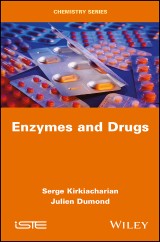Details

Enzymes and Drugs
1. Aufl.
|
126,99 € |
|
| Verlag: | Wiley |
| Format: | EPUB |
| Veröffentl.: | 11.06.2024 |
| ISBN/EAN: | 9781394299089 |
| Sprache: | englisch |
| Anzahl Seiten: | 224 |
DRM-geschütztes eBook, Sie benötigen z.B. Adobe Digital Editions und eine Adobe ID zum Lesen.
Beschreibungen
<p>Enzyme dysfunction, an essential catalyst for the smooth running of biochemical reactions and the maintenance of vital processes, is at the root of many pathologies that have paved the way for the development of numerous drugs.</p> <p>Aimed at pharmacists, biologists, biochemists, doctors, veterinarians, medicinal chemists and students from a wide range of disciplines, <i>Enzymes and Drugs</i> brings together, for the first time, extensive documentation highlighting the relationships between a large number of drugs and enzymes. The book also highlights new prospects for therapeutic discoveries offered by enzyme targeting.</p> <p>Numerous applications have been developed thanks to strategies for studying enzyme inhibition or activation, as well as the development of allosteric effectors, presented with their advantages and disadvantages. Various rare diseases, known as "orphan" diseases, have resulted from enzyme deficiency or absence. For their treatment, the introduction of substitute enzymes has led to major therapeutic advances.</p>
<p>Preface ix</p> <p>Introduction xi</p> <p><b>Chapter 1 Enzyme Kinetics, Inhibition and Activation 1</b></p> <p>1.1 Michaelis and Menten theory 2</p> <p>1.2 Irreversible inhibitors 3</p> <p>1.3 Reversible inhibitors in a Michaelian system 4</p> <p>1.3.1 Reversible competitive inhibitors 4</p> <p>1.3.2 Reversible non-competitive inhibitors 7</p> <p>1.3.3 Reversible uncompetitive inhibitors 11</p> <p>1.4 Allostery: inhibitors and activators 13</p> <p>1.4.1 Allosteric enzyme kinetics 14</p> <p>1.4.2 Mechanism of allosteric enzyme regulation 16</p> <p>1.5 References 17</p> <p><b>Chapter 2 Targeted Viral and Microbial Enzymes 19</b></p> <p>2.1 Viral targets 20</p> <p>2.1.1 Herpes group viruses: DNA-dependent DNA polymerases (EC 2) 20</p> <p>2.1.2 Influenza virus: exo-alpha-sialidase or neuraminidase (EC 3) 21</p> <p>2.1.3 HIV protease (EC 3) 22</p> <p>2.1.4 HIV reverse transcriptase (RNA/DNA-dependent DNA polymerase -- EC 2) 26</p> <p>2.1.5 HIV integrase (EC 2) 29</p> <p>2.1.6 Hepatitis C virus (HCV): RNA-dependent RNA polymerase (NS5B -- EC 2) and viral protease (NS3-4A -- EC 3) 30</p> <p>2.2 Bacterial targets 31</p> <p>2.2.1 Specific target (action mainly focused on the Mycobacterium tuberculosis species) 31</p> <p>2.2.2 General actions 33</p> <p>2.3 Fungal targets 64</p> <p>2.3.1 1,3-beta-glucan synthase (EC 2) 64</p> <p>2.3.2 Squalene mono-oxygenase (EC 1) 65</p> <p>2.3.3 14-sterol demethylase (EC 1) 65</p> <p>2.3.4 Thymidylate synthase (EC 2) 66</p> <p>2.4 Parasite targets 66</p> <p>2.4.1 Ornithine decarboxylase (EC 4) 66</p> <p>2.4.2 Heme polymerase (EC 2) 67</p> <p>2.5 References 67</p> <p><b>Chapter 3 Targeted Human Enzymes 71</b></p> <p>3.1 Treatment via effectors 71</p> <p>3.1.1 Ophthalmology 71</p> <p>3.1.2 Neurology 73</p> <p>3.1.3 Metabolism and endocrinology 79</p> <p>3.1.4 Cardiovascular and immunology 94</p> <p>3.1.5 Oncology 115</p> <p>3.1.6 Phosphatome and Kinome 131</p> <p>3.2 Enzyme replacement therapy 143</p> <p>3.2.1 Gout 143</p> <p>3.2.2 Acute leukemia and non-Hodgkin's lymphoma 144</p> <p>3.2.3 Hypophosphatasia 144</p> <p>3.2.4 Chronic obstructive pulmonary disease 144</p> <p>3.3 References 144</p> <p><b>Chapter 4 What are the New Targets? 151</b></p> <p>4.1 Inhibition and activation strategies: advantages, disadvantages and current status 151</p> <p>4.1.1 Irreversible inhibitors 152</p> <p>4.1.2 Competitive inhibitors 153</p> <p>4.1.3 Non-competitive inhibitors 155</p> <p>4.1.4 Uncompetitive inhibitors 156</p> <p>4.1.5 Allosteric effectors 156</p> <p>4.1.6 Other strategies 157</p> <p>4.2 Exogenous and endogenous targets 157</p> <p>4.2.1 Exogenous targets 158</p> <p>4.2.2 Endogenous targets 162</p> <p>4.3 Rare diseases and enzymes 166</p> <p>4.3.1 Lysosomal storage diseases 167</p> <p>4.3.2 Other rare genetic diseases linked to one or more enzymes 176</p> <p>4.4 References 176</p> <p><b>Chapter 5 Which "New" Drugs are We Moving Towards Now? 181</b></p> <p>5.1 Chemistry 181</p> <p>5.1.1 Combinatorial chemistry 181</p> <p>5.1.2 Vectorization 182</p> <p>5.2 Biology 183</p> <p>5.2.1 Inducers and repressors 184</p> <p>5.2.2 Antibodies 184</p> <p>5.3 Genetics 186</p> <p>5.3.1 Gene therapy 186</p> <p>5.3.2 Antisense strategies 193</p> <p>5.4 References 194</p> <p>Conclusion 197</p> <p>Index 201</p>
<p><b>Serge Kirkiacharian</b> holds a doctorate in physical sciences. He is a pharmacist, professor emeritus of therapeutic chemistry, hospital practitioner and honorary head of department at Paris Hospitals. His work at the CNRS, France, and in academia focuses on the development of bioactive molecules and natural products. He has also won multiple awards for his work.</p> <p><b>Julien Dumond</b> holds a doctorate in virology and enzymology. As a team leader in pharmaceutical companies and a professor of biology and bioengineering, his research focuses on the development of enzymatic assays of pharmaceutical interest, as well as premarketing studies for drugs.</p>
-
-
© 2024 media control GmbH
Alle Preise enthalten die gesetzliche Mehrwertsteuer. - AGB
- Impressum
- Datenschutzerklärung
- Kontakt
- FAQ
- Mein Konto
- Home
- Erweiterte Suche
- Widerrufsrecht
- Reader-Software
- Desktop-Ansicht
- Gutschein-Code einlösen
- English


